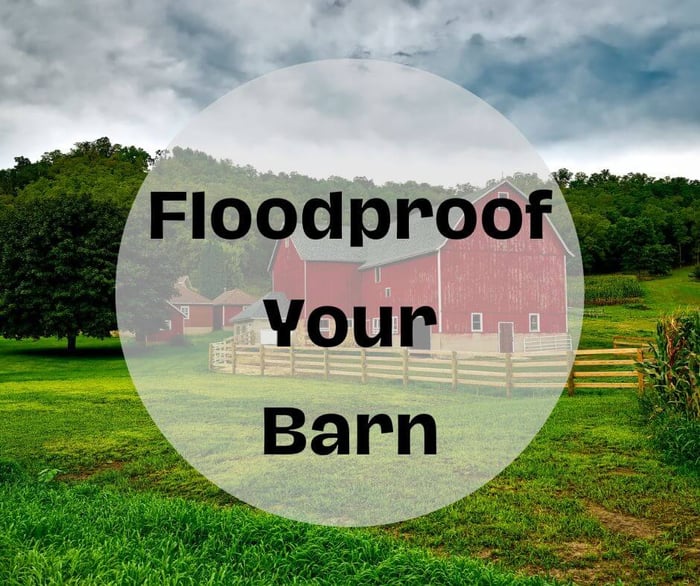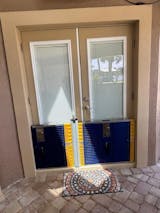A flooded barn can be a real problem. from actual safety concerns to long-term consequences like damaged livestock, equipment, and other essential possessions you may store in your barn. Here are just some reasons why you want to protect your shed from flooding:
- Livestock Safety: Floodwaters can endanger the lives of animals within the barn. Livestock may struggle to find dry and safe areas, leading to stress, injuries, and even fatalities. Swift action is essential to ensure the well-being of the animals during flooding events.
- Health Risks: Floodwaters often carry contaminants, including bacteria, chemicals, and debris. When a barn is flooded, these contaminants can compromise the health of both animals and humans. Waterborne diseases may spread among livestock, posing a risk to their overall health.
- Structural Damage: Floodwaters can cause significant damage to the structural integrity of the shed. Foundations may weaken, walls may collapse, and the overall stability of the building may be compromised. This damage can result in costly repairs and, in extreme cases, the need for complete reconstruction.
- Equipment Damage: Farms typically house valuable equipment and machinery in sheds. Flooding can damage or destroy this equipment, leading to financial losses and operational disruptions. Electrical systems within the shed may also be compromised, increasing the risk of fires or malfunctions.
- Feed Contamination: Floodwaters can contaminate stored feed, which is crucial for the nutrition of livestock. Contaminated feed poses health risks to animals, and farmers may incur additional expenses to replace the damaged feed.
- Disruption of Operations: A flooded shed can bring farm operations to a standstill. The time and effort required to clean up, repair, and replace damaged items can lead to significant downtime. This disruption can affect the daily routines of the farm, impacting productivity and income.
- Financial Losses: Dealing with the aftermath of a flooded shed often involves substantial financial costs. From repairs and replacements to potential veterinary expenses for sick animals, the financial burden can be overwhelming for farmers, especially those without adequate insurance coverage.
- Emotional Stress: Farmers invest not only financially but also emotionally in their barns and the well-being of their livestock. Seeing the destruction caused by flooding can be emotionally distressing. Dealing with the aftermath and the uncertainties of recovery can take a toll on mental well-being.
So, how do you keep your barn from flooding, and what can you do to make sure that your barn will be a safe storage place, not a soggy trap and a money pit?
How much does water damage cost?
The financial losses resulting from not protecting a barn from flooding can vary widely depending on several factors, including the severity of the flooding, the value of assets within the barn, and the costs associated with recovery and repairs. Here are some potential areas of financial impact:
- Livestock Losses: The well-being and safety of livestock are top priorities. If a barn floods and animals are harmed or lost, the financial impact can be significant. The cost includes not only the value of the animals but also potential veterinary expenses, and the long-term impact on breeding and productivity.
- Structural Damage: Floodwaters can cause structural damage to the shed, including foundation issues, damaged walls, and compromised roofing. Repairing or rebuilding the barn can entail substantial costs, including materials, labor, and potential upgrades to prevent future flooding.
- Equipment and Machinery: Sheds often house valuable equipment and machinery. If these assets are damaged or destroyed by flooding, the financial losses can be substantial. Repairing or replacing farming equipment, tools, and machinery can be a significant expense.
- Feed Contamination: Floodwaters can contaminate stored feed, rendering it unusable for livestock. The cost of replacing the contaminated feed and potential additional expenses for maintaining animal health can contribute to financial losses.
- Operational Downtime: A flooded barn can lead to operational downtime, disrupting daily farming activities. This can result in lost income and productivity. The longer it takes to recover and resume normal operations, the greater the financial impact.
- Clean-Up and Restoration: The costs associated with cleaning up and restoring the shed after a flood can add up quickly. This includes removing debris, repairing infrastructure, and implementing measures to prevent future flooding.
In other words, just flooding can cost you a fortune. That is why it is much easier and cheaper to invest in flood control.
Floodproofing a barn
Floodproofing a shed involves implementing measures to minimize the risk of flooding and protect the structure, livestock, and equipment. Modern flood control methods, including flood barriers, can be convenient and effective in safeguarding your barn. Here's a guide on how to floodproof a shed , highlighting the use of flood barriers:
- Site Selection: Start by choosing a location for your barn that is less prone to flooding. Avoid low-lying areas, riverbanks, or flood-prone regions. Select higher ground whenever possible to reduce the risk of floodwater reaching the shed .
- Elevate the Barn: If feasible, elevate the shed above the anticipated flood level. This can be achieved by building the barn on a raised foundation. Elevating the structure helps prevent floodwater from directly entering the shed and causing damage.
- Flood Barriers: Incorporate modern flood barriers as a key element of your floodproofing strategy. These barriers are convenient, easy to install, and highly effective in diverting or blocking floodwaters. Options include:
- Removable Barriers:
- Portable and easy-to-deploy barriers can be strategically placed around the barn before a flood event. These barriers act as a protective barrier, redirecting water away from the structure. Using extension poles, you can create a durable dike that protect any outdoor structure from flooding in a matter of several minutes.
$949.00
DAM EASY® FLOOD GATE - DOOR DAM Floods are becoming more common around the world. What was once a 100-year phenomenon is now a seasonal trend that homeowners must deal with. That’s EXACTLY why you need this Dam Easy Flood… Read MoreFlood Barrier Door Dam - Ultimate Flood Gate

- Inflatable Barriers:
- Inflatable flood barriers are another modern solution. These barriers can be quickly inflated and provide a watertight seal to protect against rising floodwaters. When not in use, they can be deflated and stored until needed. However, these barriers may have some Cons as well. Their lifetim is pretty restricted and they will not help against salty water, which will literally "eat them alive".
- Modular Flood Barriers:
- Modular flood barriers are pre-engineered systems that can be customized to fit the specific dimensions of your barn. These systems are often made of durable materials and can be quickly assembled to create a reliable flood defense. However, you may need some training to use this solution and several assistants to assemble a modular dike.
- Waterproofing: Ensure that the shed is properly waterproofed to prevent water infiltration. Apply water-resistant sealants to exterior surfaces, paying attention to vulnerable areas such as doors, windows, and foundation joints. Consider using waterproof membranes and coatings on walls and floors.
- Sump Pumps and Drainage: Install sump pumps inside the barn to remove any water that may enter during a flood. Additionally, implement effective drainage systems around the shed to redirect water away. Regular maintenance of sump pumps is essential to ensure their functionality.
- Electrical Precautions: Elevate electrical systems, including outlets, switches, and wiring, above potential flood levels to prevent electrical damage. Consider installing circuit breakers that can automatically shut off power in case of flooding to reduce the risk of electrical hazards.
- Emergency Plan: Develop an emergency plan that includes procedures for evacuating livestock, securing valuable equipment, and implementing flood control measures. Ensure that all farm personnel are familiar with the plan and conduct regular drills.
Floodproofing your shed is a proactive step in protecting your investments and ensuring the safety of your livestock. By incorporating modern flood control methods, such as flood barriers, you can enhance the effectiveness of your floodproofing measures and reduce the impact of potential flooding events. Regular maintenance and staying informed about weather conditions are also crucial components of a comprehensive flood preparedness strategy.
Contact Dam Easy today to learn more about modern flood barriers and other flood control solutions for any kind of property. If you are located in Florida, our team can come directly to your place, evaluate the flood risks, and suggest the best anti-flooding solutions for your property. However, we work and deliver worldwide, so don`t hesitate to contact us today, use our Calculator, and make flood safety as Dam Easy as it gets.





















